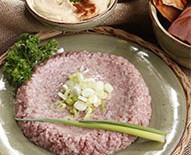Like any major world city, Beirut is complex and engulfing. Nine days were enough to viscerally grasp how much time I’d really need to spend there to even superficially understand its intricacies. The confluence of cultures, religions, and languages is singular; I loved how within two sentences of conversation I’d hear Arabic, French and English words strung together instinctively. One quiet late-night, after drinks at Anise on the bar-packed Mar Mikhael, Caline, Natalie and I walked nearly the span of the city to return home. We gazed up at the blue-domed Mohammad Al-Amin Mosque downtown and the neoclassical St. Georges Maronite Cathedral next to it, and then stared down into the ruins of the Roman baths three blocks away.
We ate hard. We worried the staff of breakfast institution Al Soussi with the enormous feast we requested, including fatteh (spiced chickpeas with yogurt, crisped pita and pine nuts), foul (cumin-scented dried fava beans simmered nearly into a puree), hummus with lamb, pickles and olives. The manti (tiny dumplings, pleated to precise squares and covered in yogurt sauce) at Armenian standard-bearer Varoujwere incredible. We debated kibbeh nayyeh — raw, gently spiced lamb ground smooth with bulgur and drizzled with good olive oil; my favorite Lebanese dish — over brunch at Liza and lunch at Tawlet (the latter won). We toured Chateau Musar, whose eloquent reds and orangey whites I seek out on wine lists everywhere.
For one blowout dinner of mezze and grilled meats in Beirut, the famous Em Sherifdelivered; I really understood there that the dough for fatayer needs to be rolled way thinner than most varieties I’ve tasted in the States. Every food writer in town nudged us to Fadel in the mountains above the city; even the skeptics in the group agreed the tomato salad and miniature fried kibbeh were excellent.
There was a Thursday I wish I had filmed so I could recall it perfectly, to protect it from any warping twists of memory. At the center of it was a meal in the mountains shared with two women, Nadine Touma and Sivine Ariss, who run a publishing house called Dar Onboz that creates sumptuously illustrated children’s books and graphic novels. They arranged lunch for us at a tiny restaurant — its name translated from Arabic as “Cedars Resthouse” — in a town called Maaser El Chouf, near a forest reserve protecting ancient groves of cedar trees. Our host was a woman called Sheikha Wafa; she wore the traditional long black dress and white head covering of women in the Druze religion.
Man’oushe is a traditional Lebanese flatbread, rolled into a circle, laid on a griddle called a saj and covered with a variety of ingredients while it cooks. Sheikha Wafa made two for us: one with za’atar, the spice mixture built around dried wild thyme and revived in olive oil, and another with kashk, dried yogurt mixed with tomato and sesame. She spread them on the dough in slow, meditative gestures. They were the best of the trip. She also prepared eggs fried in qawarma, lamb preserved in its own fat. They joined a table chockablock with bowls of tiny cucumbers and labneh, salads of fresh wild thyme and purslane, pickled eggplant and a wonderful grated potato dish that reminded me of soft hash browns.
Afterward, we reveled in the mountaintop view and lingered over a tisane steeped using Sheikha Wafa’s own dried herbs. We each sipped from the same cup using a metal straw that was cleaned, as is tradition, with a lemon leaf before the next person drinks.
It didn’t feel like the restaurants in which I spend my professional life. It spanned the gulf between business and home. It was a third place.
It’s hard to break the reverie; I’m happy, though, to be back home in Los Angeles. I don’t expect to re-create the experiences I had at the source. That said: If you know of an outstanding Lebanese restaurant in Southern California, I’d love to hear about it; tell me exactly what to order at bill.addison@latimes.com.
ASK THE CRITICS
Why does Arabic/Middle Eastern food get lumped into Mediterranean?
—@jayarebeisme, Instagram
This is such a prescient question, given my recent travels and interest in the cuisines of the Middle East, that I’m going to dig into the topic fully in a future newsletter. If y’all have thoughts in the meanwhile, email me.Facebook


